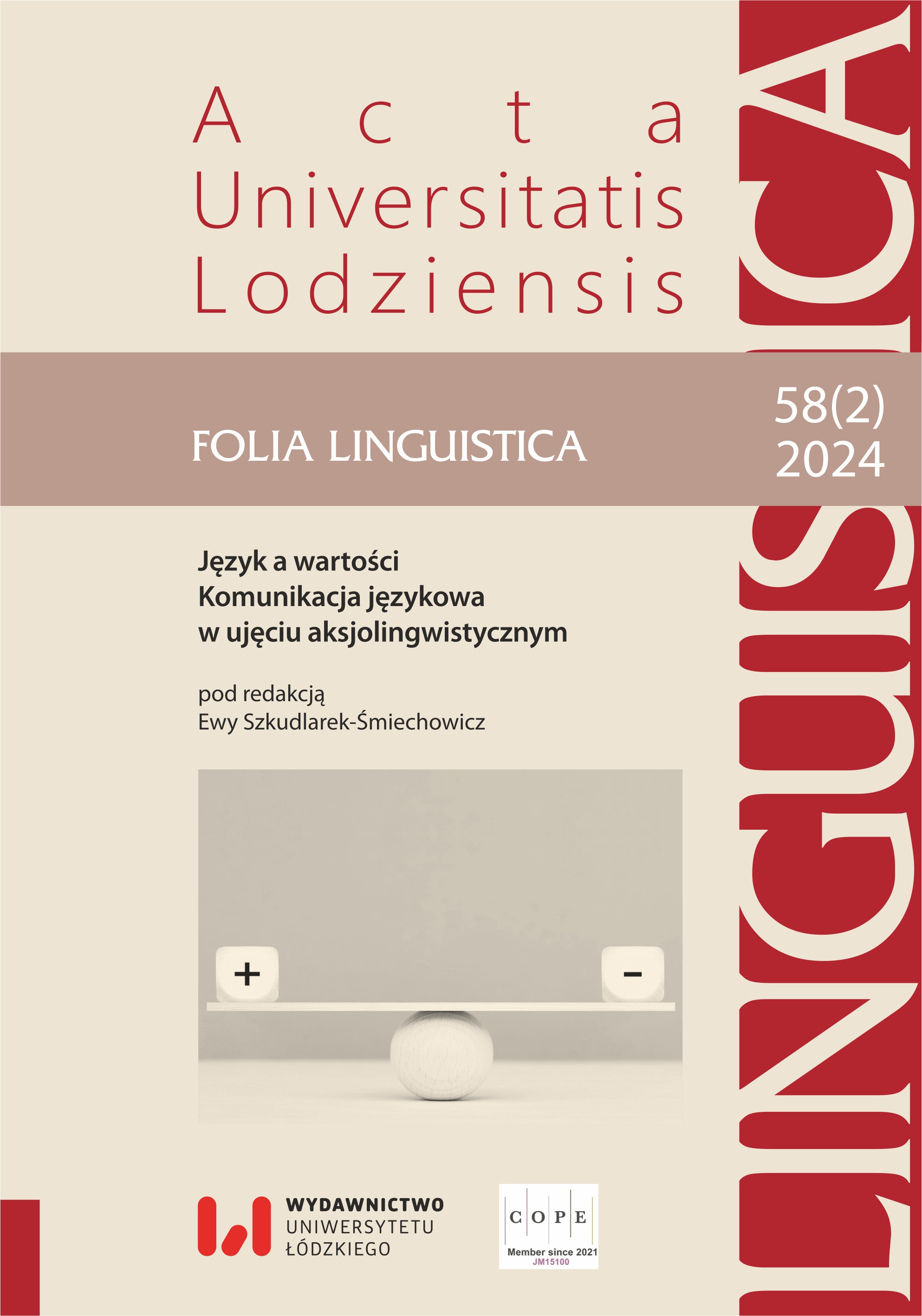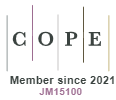Semantic prosody in political discourse (Polish-Slovak comparison)
DOI:
https://doi.org/10.18778/0208-6077.58.2.03Keywords:
political discourse, the election programme, semantic prosodyAbstract
The article presents the issue of semantic prosody in political discourse in a confrontative Polish-Slovak perspective. The objects of the description are lexical units having positive or negative semantic prosody in a specific context. This phenomenon, identified in the work by Louw (1993) and developed by Sinclair (2003, 2004), consists in lexical units (mainly verbs and adjectives) acquiring a value as a result of textual connectivity with other units. The aim of this text is to show that semantic prosody can also be common to other parts of speech, as indicated by the given examples of adjectives, adverbs, and nouns occurring in the texts of programs of Polish and Slovak political parties. This material was chosen because programs are a genre in which political parties communicate the vision of political order they are creating.
Downloads
References
Baker P., Ellece S., 2011, Key Terms in Discourse Analysis, London–Oxford–New York–New Delhi–Sydney: Bloomsbury Academic.
Google Scholar
Bańko M. (red.), 2000, Inny słownik języka polskiego, Warszawa: PWN.
Google Scholar
Bańko M., 2008, O tzw. prozodii semantycznej i jej opisie w słownikach, w: P. Żmigrodzki, R. Przybylska (red.), Nowe studia leksykograficzne II, Kraków: Lexis, s. 151–161.
Google Scholar
Bańko M., 2014, Słownik dobrego stylu czyli wyrazy, które się lubią, Warszawa: PWN.
Google Scholar
Bednarek M., 2008, Semantic preference and semantic prosody re-examined, „Corpus Linguistics and Linguistic Theory”, t. 4–2, s. 119–139. https://doi.org/10.1515/CLLT.2008.006
Google Scholar
DOI: https://doi.org/10.1515/CLLT.2008.006
Czyżewski M., 2010, Trzy rodzaje dyskursu, w: S. Kowalski, M. Czyżewski, A. Piotrowski (red.), Rytualny chaos. Studium dyskursu publicznego, Wrocław: Wydawnictwa Akademickie i Profesjonalne, s. 18–29.
Google Scholar
Hebal-Jezierska M., 2016, Preferencja i prozodia semantyczna leksemów odnoszących się do członków mniejszości wietnamskiej w językach zachodniosłowiańskich (badanie korpusowe), „Zeszyty Łużyckie”, t. 50, s. 293–309.
Google Scholar
Hunston S., 2007, Semantic prosody revisited, „International Journal of Corpus Linguistics”, nr 12:2, s. 249–268. https://doi.org/10.1075/ijcl.12.2.09hun
Google Scholar
DOI: https://doi.org/10.1075/ijcl.12.2.09hun
Kamasa V., 2015, Prozodia semantyczna. Pojęcie, problemy, przydatność, „Socjolingwistyka”, t. 29, s. 105–120. http://dx.doi.org./10.17651/SOCJOLING.29.6
Google Scholar
DOI: https://doi.org/10.17651/SOCJOLING.29.6
Lewandowska-Tomaszczyk B., 1996, Negativity and Semantic Prosody in Depth of Negation — A Cognitive Semantic Study, Łódź: Wydawnictwo Uniwersytetu Łódzkiego, s. 187–218.
Google Scholar
Louw B., 1993, Irony in the text or insincerity in the writer? — the diagnostic potential of semantic prosodies, w: M. Baker, G. Francis, E. Tognini-Bonelli (red.), Text and Technology: in honour of John Sinclair, Amsterdam: Benjamins, s. 157–176. https://doi.org/10.1075/z.64.11lou
Google Scholar
DOI: https://doi.org/10.1075/z.64.11lou
Makowska K., 2022, Potencjał kolokacyjny leksemów telefon i komputer w świadomości językowej dzieci pięcioletnich, „Białostockie Archiwum Językowe”, nr 22, s. 223–248. https://doi.org/10.15290/baj.2022.22.13
Google Scholar
DOI: https://doi.org/10.15290/baj.2022.22.13
Partington A., 1998, Patterns and Meaning. Using Corpora for English Language Research and Teaching, Amsterdam/Philadelphia: Benjamins. https://doi.org/10.1075/scl.2
Google Scholar
DOI: https://doi.org/10.1075/scl.2
Partington A., 2004, Utterly content in each other’s company: Semantic prosody and semantic preference, „International Journal of Corpus Linguistics”, nr 9 (1), s. 131–156. https://doi.org/10.1075/ijcl.9.1.07par
Google Scholar
DOI: https://doi.org/10.1075/ijcl.9.1.07par
Przybylska R., 2020, Kolokacje a analiza semantyczna wyrazu, „LingVaria”, nr 2 (30), s. 43–51. https://doi.org/10.12797/LV.15.2020.30.04
Google Scholar
DOI: https://doi.org/10.12797/LV.15.2020.30.04
Sinclair J., 2003, Reading concordances: An introduction, London–New York: Pearson/Longman.
Google Scholar
Sinclair J., 2004, Trust the text: Language, corpus and discourse, New York: Routledge. https://doi.org/10.4324/9780203594070
Google Scholar
DOI: https://doi.org/10.4324/9780203594070
Sojda S., 2009, Politická komunikácia na poľských a slovenských internetových stránkach, w: M. Kováčová (red.), Literatúra v kontexte slovanskej kultúry XX storočia, Banská Bystrica: Univerzita Mateja Bela, s. 142–147.
Google Scholar
Sojda S., 2010, Słowacka i polska politolingwistyka, w: H. Mieczkowska, A. Hudymač, Z. Babik (red.), Z warsztatu współczesnego słowacysty. Studia słowacystyczne dedykowane pamięci Profesor Marii Honowskiej, Kraków: Wydawnictwo Uniwersytetu Jagiellońskiego, s. 95–100.
Google Scholar
Stubbs M., 1996, Text and Corpus Linguistics, Oxford: Blackwell Publishers.
Google Scholar
Stubbs M., 2001, Words and phrases: Corpus studies of lexical semantics, Oxford: Blackwell Publishers.
Google Scholar
Szewczyk M., 2007a, O jednym ze sposobów „przemycania” negatywnych sądów wartościujących, w: A. Oskiera (red.), Antynomie wartości. Problematyka aksjologiczna w językoznawstwie, Łódź: Wyższa Szkoła Humanistyczno-Ekonomiczna w Łodzi, s. 275–280.
Google Scholar
Szewczyk M., 2007b, Prozodia semantyczna (semantic prosody) a znaczenie wyrazu, w: A. Dobaczewski (red.), Studia nad współczesną polszczyzną. Gramatyka, semantyka, pragmatyka, Toruń: Wydawnictwo Uniwersytetu Mikołaja Kopernika, s. 261–266.
Google Scholar
Whitsitt S., 2005, A critique of the concept of semantic prosody. „International Journal of Corpus Linguistics”, t. 10, s. 283–305. https://doi.org/10.1075/ijcl.10.3.01whi
Google Scholar
DOI: https://doi.org/10.1075/ijcl.10.3.01whi
Woźniak W., 2017, Programy polskich partii politycznych jako materiał empiryczny w badaniach dyskursu politycznego. „Środkowoeuropejskie Studia Polityczne”, t. 2, s. 41–58. https://doi.org/10.14746/ssp.2017.2.3
Google Scholar
DOI: https://doi.org/10.14746/ssp.2017.2.3
Downloads
Published
How to Cite
Issue
Section
License

This work is licensed under a Creative Commons Attribution-NonCommercial-NoDerivatives 4.0 International License.










